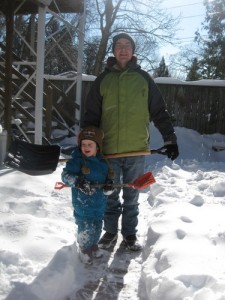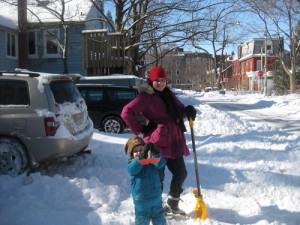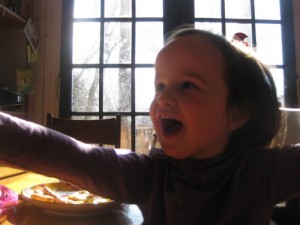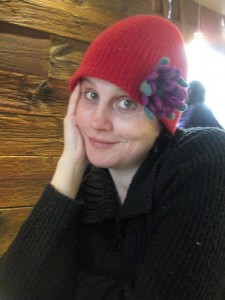February 15, 2013
Valentines Aftermath
 I really do love my Valentine. Our plan was to celebrate tonight with dinner out and tickets to “Do You Want What I Have Got? A Craigslist Cantata”. It has been a wild week, what with the excitement of the book deal announcement, me finishing a draft of another project that has owned my life for the past six weeks, and the most atrocious day of parenthood on Wednesday that left me in tears and in despair at what we’d wrought on the world by delivering it this child. I’m starting to lose my second-trimester thunder, and fatigue is creeping in–my midwife appoints now becoming biweekly! Terrifying! Further, it ocurred to me suddenly on Wednesday evening that it is February, which never really kicks in until halfway through but when it does, the month is hard to beat. February can make everything seem quite unbearable, no matter how much loveliness is going around. Once I realized it was February though, everything seemed better. It wasn’t all me after all.
I really do love my Valentine. Our plan was to celebrate tonight with dinner out and tickets to “Do You Want What I Have Got? A Craigslist Cantata”. It has been a wild week, what with the excitement of the book deal announcement, me finishing a draft of another project that has owned my life for the past six weeks, and the most atrocious day of parenthood on Wednesday that left me in tears and in despair at what we’d wrought on the world by delivering it this child. I’m starting to lose my second-trimester thunder, and fatigue is creeping in–my midwife appoints now becoming biweekly! Terrifying! Further, it ocurred to me suddenly on Wednesday evening that it is February, which never really kicks in until halfway through but when it does, the month is hard to beat. February can make everything seem quite unbearable, no matter how much loveliness is going around. Once I realized it was February though, everything seemed better. It wasn’t all me after all.
We’ve been in the market for new bedroom furniture, a queen-size bed in case the new baby decides to bunk in with us, because a double bed doesn’t cut it for such things, plus I recently found the receipt for our mattress which we bought in 2005 when we were so so poor and it cost us $200! (I remember at the time thinking it was very expensive, and so it’s no surprise that it’s not holding up so well 8 years later.) This week, I found a Craigslist ad from a woman who was selling her entire bedroom suite for a very reasonable prize, so we booked the Autoshare Cargo van (and a babysitter) and went to pick it up last night. Not a very romantic Valentines, we supposed, carrying a bedframe, two bedside tables, and two dressers out of a condo building, and then up the two flights of stairs into our bedroom. But now we had a bedroom suite! Furniture that matches! I never imagined such a thing was even a possibility. We still have to buy a boxspring and a new mattress, our house is in complete disarray, and if anyone wants to pick up a bed that my mom bought at a farm auction in 1976, I’m your man! But we love the new furniture.
We hauled the furniture inside, and supposed the worst of the night was done, but it actually turned out to be just the beginning. Harriet woke up screaming with a problem I’m not going to get into, but google searches provided no answers, and so we opted to take her to the hospital. We were only there for two hours, but as ever, a trip to the Hospital for Sick Children provides enormous perspective ie the child in line ahead of us whose parents feared was rejecting her transplanted liver. It was the first of all our annual visits to the hospital too where I wasn’t imagining terrible scenarios that would require us to be in the hospital for weeks at a time. I knew she was fine. Our visit was unpleasant, but to be borne (so bravely by our little one too), and we were home in two hours. Walking out of that place with my healthy girl in my arms remains the greatest luxury of my entire existence, even more so than matching bedside tables.
Anyway, my point was that from a tactical standpoint, our Valentines Day was a romantic disaster. Worst night ever. But it wasn’t, actually, because we were in it together, hauling enormous dressers or entertaining Harriet in the waiting room with a pen and an elastic band. As I said to my beloved Valentine this morning, “There is not a road that I wouldn’t be willing to walk down with you.”
February 13, 2013
After Claude by Iris Owens
 “‘…Harriet, Harriet,” she moaned, and it passed through my mind that of all the countless treacheries my mother had perpetuated, naming me Harriet was the most infamous.” (p. 62)
“‘…Harriet, Harriet,” she moaned, and it passed through my mind that of all the countless treacheries my mother had perpetuated, naming me Harriet was the most infamous.” (p. 62)
“I can’t describe how impossible it is to pronounce the name Harriet to a hidden audience. When you say it, you need to deal on the spot with the listener’s reactions. To call a child Harriet is to condemn her to mediocrity.” (p. 146)
Of all the literary Harriets, I do believe that Iris Owens’ is my favourite. In her novel After Claude, Owens’ has created an unlikeable female character who manages to be irresistible. Which is amazing, but more than that, she isn’t stupid, or scattered, or zany, and not once does Iris Owens’ Harriet fall off a chair. Here is a rare thing: a comic heroine who does not embody silliness. Which isn’t to say that Harriet is mentally stable, exactly, and she’s certainly not as smart as she thinks she is, but then that is setting a high standard for anyone. Further: she suffers precisely NO self-esteem issues. To be fair, she could probably afford to take on one or two, but how refreshing that she never does. That she’s utterly un-neurotic.
How does Owens do it? I can’t figure it out exactly. I’ve thought a lot in my time about unsympathetic female characters, and how little us readers can bear them. That we’re so much harder on the women than the men who fall into the loser-lit genre. Part of it could possibly be that Owens gives us just a few days in the life of her Harriet so we can bear her that long, and moreover that we can discern that underneath of veneer or self-assurance (and really, it’s a voice that wins you over to it) that Harriet is absolutely powerless. She gets as bad as she gives. As was Jim in Lucky Jim, just say, whereas the unlikeable characters in Christine Pountney’s The Best Way You Know How or Kate Christensen’s In the Drink, for example, were characters with enough agency who’d just squandered it by being irresponsible, by making stupid decisions, by having dreams of Bohemian grandeur that don’t add up to much. Perhaps the problem with female loser-lit is that authors are rarely brave enough to situate their character at rock bottom.
“I left Claude, the French rat,” the book begins, and a careful reader will note a wide gulf between Harriet’s perception of matters and what appears to be reality. We figure out quickly from various cues that Harriet is a parasite, lazy and irresponsible, a person who makes up her own history as she goes along. She’s spent the last six months living with her boyfriend Claude, but he’s had enough and wants her out. He’d first encountered her crying on the doorstep of their building after the friend she’d been staying with the on the first floor had tossed all her belongings out the window (after Harriet had snuck a strange man into the friend’s bed to enact a rape fantasy. Clearly with Harriet, no explanation is ever straightforward). She’d spent a period of time in Europe which she attempts to define herself by, though it’s clear that some kind of similar drama to the others is what had sent her back home to America. And now Claude wants to be rid of her, but Harriet’s not budging, even going as far as to get the locks changed, which is far for Harriet who can’t usually summon the initiative to get out of bed.
Oh, she is horrible and scathing, one of those people who calls the world as she sees it. Likes like this like, about her friend, the former roommate, “How often I used to tell her, ‘Rhoda, stop brooding about your size. Having a perfect figure may be a blessing but believe me, it’s not the only thing in life. A saint may come along who is not primarily concerned with with proportions, but when he does, if you drag him in here, be prepared to administer mouth-to-mouth resuscitation.'” There was just something about the voice that won me over, lines like, “Unless he had magically transformed himself into a book of matches stuck to my ass, he was definitely not in the bed.” Humour, as always, is a relative thing, but I found After Claude absolutely hilarious.
Harriet is one of those women Caitlin Moran writes about in How to Be a Woman, a woman who enacts entire relationships in her mind, except that in her mind, Harriet has reinvented the entire world. Her point of view nearly unbudging–that she is is smarter than everybody around her, envied, beautiful, and that she’s going places even when she’s stopped. And it’s true that many of the people around her are so obnoxious that you start to see her point, that she looks good on them, really. Harriet is so sure of herself that the reader can almost believe it.
But not quite, however much we’d like to. The novel’s final third takes place at the Chelsea Hotel where Claude has finally been rid of Harriet, and she falls into strange company across the hall, an odd party populated by members of a cult and she latches onto their leader as she does to every single man she ever encounters, and he gets the better of her, but not without giving her something in return. The novel ends with Harriet back in her room in her single bed: “I had no thoughts, only a dim awareness of myself listening and waiting.” Which is actually the strongest awareness of herself that Harriet has ever shown us that she has.
Iris Owens’ biography contains the detail that she was “the daughter of a professional gambler”. She made her reputation as a pornographer writing under the name “Harriet Daimler” for the Olympia Press in Paris during the 1950s. After Claude, published in 1973, is one of two novels she published under her own name, and the other was based upon her marriage to an Iranian Prince. So that is Owens, who is anything but boring, and I promise you that her novel is even more ever so much so.
February 11, 2013
News!! Truth, Dare, Double Dare: Coming in April 2014
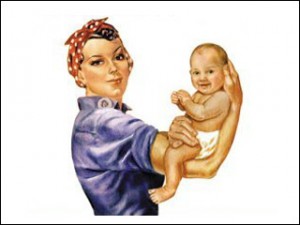 I started talking about motherhood three and a half years ago, joining a conversation that I’d never supposed could be so absorbing, perplexing, and reflective of larger issues and politics. And as I talked about motherhood more and more, it began to occur to me how alienating was that conversation to so many other women, whether they were mothers themselves, or had wanted to be, or had become mothers in ways that were less than straightforward, or had never wanted to be mothers at all. I started to see how the motherhood conversation was not nearly wide enough to encompass women’s diverse experiences of motherhood, and maternal things. I began to see how understanding the various relationships that women have to motherhood could tell us a lot about about women’s lives today, the real nature of “choice”, and how far feminism has brought us (or not, in some cases).
I started talking about motherhood three and a half years ago, joining a conversation that I’d never supposed could be so absorbing, perplexing, and reflective of larger issues and politics. And as I talked about motherhood more and more, it began to occur to me how alienating was that conversation to so many other women, whether they were mothers themselves, or had wanted to be, or had become mothers in ways that were less than straightforward, or had never wanted to be mothers at all. I started to see how the motherhood conversation was not nearly wide enough to encompass women’s diverse experiences of motherhood, and maternal things. I began to see how understanding the various relationships that women have to motherhood could tell us a lot about about women’s lives today, the real nature of “choice”, and how far feminism has brought us (or not, in some cases).
It all started with my friends, really, whose experiences of infertility, adoption, abortion, maternal ambivalence, miscarriage, being child-free were so absolutely ordinary in so many ways, but were also represented as being far outside the bounds of the motherhood conversation. I wondered if there was a way that these experiences could be included in a broadened conversation, along with stories of stepmothering, grandmothering, single motherhood, other relationships with children that weren’t necessarily biological, having many children, having only one, having children die, worrying about having children die, exercising choice, or having choice taken away from you.
It was last December when I was talking about this with my friend Amy Lavender Harris, and she said, “This would make a really good anthology.” That night, I got to work emailing women writers I knew whose stories fit the bill. I spent last winter and spring contacting writers, so many of whom responded with complete support for this project. I spent the summer writing my own piece (over four amazing days at the Wychwood Library, during which I listened to “Call Me Maybe” on repeat) and was constantly aglow with the idea that all over this country were brilliant women were busily at work creating this book with me. They sent me their essays and they were wonderful, and I spent late-summer and Fall putting the pieces all together.
And now I am happy to report that the news is official. Our book, Truth, Dare, Double Dare: Stories of Motherhood will be published in April 2014 by Goose Lane Editions, whose people have been as supportive of this project as I could have dreamed of. Key champion has been my agent Samanatha Haywood–I feel so lucky to have her in my corner. And my mind has been blown by the generosity and brilliance of the women who came together to make this book possible: Heather Birrell, Julie Booker, Diana Fitzgerald Bryden, Myrl Coulter, Christa Couture, Heather Cromarty, Nancy-Jo Cullen, Marita Dachsel, Ariel Gordon, Amy Lavender Harris, Alexis Kienlen, Fiona Tinwei Lam, Michele Landsberg, Deanna McFadden, Maria Meindl, Saleema Nawaz, Susan Olding, Alison Pick, Heidi Reimer, Kerry Ryan, Sarah Yi-Mei Tsiang, Carrie Snyder, Patricia Storms, Zoe Whittall and Julia Zarankin. Each of these writers has underlined the one thing I’ve always been sure of, which is that women are absolutely amazing.
February 11, 2013
Love Stories for Little Readers
When February comes around, even the littlest readers start thinking about love and cinnamon hearts. But of course, love itself is not all cupids and doilies, nor is it even store-bought Valentine cards distributed to every student in the class. Here is a great list of literary love stories that are ideally suited to a child’s perspective, demonstrating the amazing possibilities and benefits of love, friendship and family connections.
 Oscar’s Half-Birthday by Bob Graham: I adore this story of family life in the city, of two parents and a big sister who are so in love with their Baby Oscar that they can’t possibly wait all the way until his birthday to celebrate his baby goodness. And so on the occasion of Oscar’s half-birthday, they pack a picnic and trek up to the park. The celebration starts small, but by the time they’ve finished singing “Happy Birthday”, the chorus has been picked up by people all around them, and the world is alive with song, community and connection.
Oscar’s Half-Birthday by Bob Graham: I adore this story of family life in the city, of two parents and a big sister who are so in love with their Baby Oscar that they can’t possibly wait all the way until his birthday to celebrate his baby goodness. And so on the occasion of Oscar’s half-birthday, they pack a picnic and trek up to the park. The celebration starts small, but by the time they’ve finished singing “Happy Birthday”, the chorus has been picked up by people all around them, and the world is alive with song, community and connection.
 Without You by Geneviève Côté: Winner of the 2012 Marilyn Baillie Picture Book Award, Côté’s book is her second about two friends, Pig and Bunny, whose differences can sometimes come between them. In Without You, the friends have a falling out and decide that they don’t really need one another anyway. But everything from reading books to baking cookies turns out to be quite lonely without the other, and Pig and Bunny realize how much richer the world is when they are together. Love isn’t easy, but it’s worth it.
Without You by Geneviève Côté: Winner of the 2012 Marilyn Baillie Picture Book Award, Côté’s book is her second about two friends, Pig and Bunny, whose differences can sometimes come between them. In Without You, the friends have a falling out and decide that they don’t really need one another anyway. But everything from reading books to baking cookies turns out to be quite lonely without the other, and Pig and Bunny realize how much richer the world is when they are together. Love isn’t easy, but it’s worth it.
 Frog and Toad by Arnold Lobel: For easy-read texts, Arnold Lobel’s Frog and Toad books have remarkably depth. I continue to maintain that “The Letter” (from the Frog and Toad are Friends collection) is one of the best short stories I have ever read. The two friends face their fears and foibles together, and even their most mundane adventures result in humour, poignance, and surprises. I might declare that Frog and Toad are literature’s greatest companions (and it’s no surprise, really, that they were James Marshall’s inspiration for the als0-excellent George and Martha books).
Frog and Toad by Arnold Lobel: For easy-read texts, Arnold Lobel’s Frog and Toad books have remarkably depth. I continue to maintain that “The Letter” (from the Frog and Toad are Friends collection) is one of the best short stories I have ever read. The two friends face their fears and foibles together, and even their most mundane adventures result in humour, poignance, and surprises. I might declare that Frog and Toad are literature’s greatest companions (and it’s no surprise, really, that they were James Marshall’s inspiration for the als0-excellent George and Martha books).
 Should I Share My Ice-Cream? by Mo Willems: And speaking of literature’s great companions, you really can’t go wrong with any of Mo Willems’ Elephant and Piggie books. They’re simple, silly and definitely funny. In this one, Elephant Gerald is faced with a quandary: just how much is a friend required to give of himself (and his treats?). In the end, however, he realizes that the mathematics of friendship are really quite simple, and he is just lucky to be their beneficiary.
Should I Share My Ice-Cream? by Mo Willems: And speaking of literature’s great companions, you really can’t go wrong with any of Mo Willems’ Elephant and Piggie books. They’re simple, silly and definitely funny. In this one, Elephant Gerald is faced with a quandary: just how much is a friend required to give of himself (and his treats?). In the end, however, he realizes that the mathematics of friendship are really quite simple, and he is just lucky to be their beneficiary.
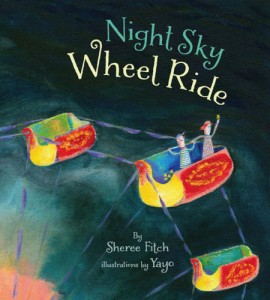 Night Sky Wheel Ride by Sheree Fitch, illustrated by Yayo: All of Sheree Fitch’s books are love stories, odes to language and to life itself. From this one, I love the line, “Can you hear the mermaids murmur/beluga whales sing/ feel the whirling stir/ of every little humming phosphorescent thing?” But this is also the story of a brother and a sister, about how much braver they can be when they’re together. And Night Sky Wheel Ride takes on a particular poignance when you learn about the real life story that inspired it.
Night Sky Wheel Ride by Sheree Fitch, illustrated by Yayo: All of Sheree Fitch’s books are love stories, odes to language and to life itself. From this one, I love the line, “Can you hear the mermaids murmur/beluga whales sing/ feel the whirling stir/ of every little humming phosphorescent thing?” But this is also the story of a brother and a sister, about how much braver they can be when they’re together. And Night Sky Wheel Ride takes on a particular poignance when you learn about the real life story that inspired it.
 Who Will Comfort Toffle? by Tove Janssen: We are crazy about the Moomins at our house, and are so pleased that two of Janssen’s picture books are newly in print and translated into English thanks to the good people at Drawn & Quarterly. In this one, Toffle the loner ventures out into the world, skirting its shadows and avoiding company as well as danger. It turns out that no Toffle is an island though–he finds a message in a bottle from a Miffle in need of his help. Being needed provides Toffle with the purpose he’s been seeking all along, as well as necessary companionship. I love the ending: “‘Forget the past and all your fears. Think of all the super fun/ That we can have. I’d love to see the beach, a shell, the sun…’/And Miffle knows and Toffle knows, that both have seen the end/ Of fear and fright and long, dark night, now each has found a friend.”
Who Will Comfort Toffle? by Tove Janssen: We are crazy about the Moomins at our house, and are so pleased that two of Janssen’s picture books are newly in print and translated into English thanks to the good people at Drawn & Quarterly. In this one, Toffle the loner ventures out into the world, skirting its shadows and avoiding company as well as danger. It turns out that no Toffle is an island though–he finds a message in a bottle from a Miffle in need of his help. Being needed provides Toffle with the purpose he’s been seeking all along, as well as necessary companionship. I love the ending: “‘Forget the past and all your fears. Think of all the super fun/ That we can have. I’d love to see the beach, a shell, the sun…’/And Miffle knows and Toffle knows, that both have seen the end/ Of fear and fright and long, dark night, now each has found a friend.”
 Lumpito and the Painter from Spain by Monica Kulling, illustrated by Dean Griffiths: I don’t know any kid who doesn’t love a story about a dog. This particular one is about a dachshund who goes to visit Pablo Picasso, and steals the painter’s heart. Lump has canine adventures with paper rabbits, a goat, and becomes immortalized in his new Master’s artworks.
Lumpito and the Painter from Spain by Monica Kulling, illustrated by Dean Griffiths: I don’t know any kid who doesn’t love a story about a dog. This particular one is about a dachshund who goes to visit Pablo Picasso, and steals the painter’s heart. Lump has canine adventures with paper rabbits, a goat, and becomes immortalized in his new Master’s artworks.
 The Owl and the Pussycat By Edward Lear, illustrated by Stéphane Jorisch: Lear’s curious and beautiful poem is reborn with Jorisch’s illustrations, which give readers a vivid picture of things like bong trees and runcible spoons. The unlikely pair is a cat from the wrong side of the tracks and the owl who loves her, both of them fleeing society’s disapproval via a pea-green boat (equipped with some honey and plenty of money). Read this book a few times and you’ll know the whole thing by heart: “And hand in hand by the edge of the sand, they danced by the light of the moon, the moon, the moon. They danced by the light of the moon.”
The Owl and the Pussycat By Edward Lear, illustrated by Stéphane Jorisch: Lear’s curious and beautiful poem is reborn with Jorisch’s illustrations, which give readers a vivid picture of things like bong trees and runcible spoons. The unlikely pair is a cat from the wrong side of the tracks and the owl who loves her, both of them fleeing society’s disapproval via a pea-green boat (equipped with some honey and plenty of money). Read this book a few times and you’ll know the whole thing by heart: “And hand in hand by the edge of the sand, they danced by the light of the moon, the moon, the moon. They danced by the light of the moon.”
February 10, 2013
Flip Turn by Paula Eisenstein
 Flip Turn, the debut novel by Paula Eisenstein, is a wonderful companion to Leanne Shapton’s memoir Swimming Studies, using fiction to address many of the questions Shapton posed in her book. What does it it mean to be defined in one’s youth by a competitive sport? How can you be yourself without the sport? Does having natural talent hinder one from trying anything that doesn’t come easy? And where does the discipline of competitive athletics come from? Where does it go when the sport is gone? Eisenstein too delves into the peculiar culture of competitive swimming, the smell of chlorine, greeny blond hair, how you should not in fact stow your wet suit in a plastic bag after morning practice but rather roll it in your towel, otherwise it will still be wet for practice later in the later and therefore impossible to put on.
Flip Turn, the debut novel by Paula Eisenstein, is a wonderful companion to Leanne Shapton’s memoir Swimming Studies, using fiction to address many of the questions Shapton posed in her book. What does it it mean to be defined in one’s youth by a competitive sport? How can you be yourself without the sport? Does having natural talent hinder one from trying anything that doesn’t come easy? And where does the discipline of competitive athletics come from? Where does it go when the sport is gone? Eisenstein too delves into the peculiar culture of competitive swimming, the smell of chlorine, greeny blond hair, how you should not in fact stow your wet suit in a plastic bag after morning practice but rather roll it in your towel, otherwise it will still be wet for practice later in the later and therefore impossible to put on.
For Eisenstein’s unnamed narrator, competitive swimming offers welcome escape from a horrifying incident in her family’s past. Her older brother had been convicted of murdering a young girl at the local YMCA in their hometown of London ON, and the family cannot help being defined by that event both among themselves and in the wider community. The protagonist of Flip Turn views her swimming successes as a chance to tell a different story about their family life, to change the narrative. If she is good, then her family is good, she figures, which is a heavy burden for a young girl to carry on her shoulders no matter how muscular those shoulders are.
In the pool is the one place where she belongs, where both her mind and her body know exactly what she needs to do in order to be successful. Whereas, at school and even among her teammates, she’s not comfortable in her skin, always feeling like an outsider, partly due to her brother’s infamy or at least her consciousness of it, and also due to the fact that to be teenaged is always to feel like something of a misfit. Home is no better–she is all too aware of the fractures in her family, tip-toeing around her parents in order to be everything her brother wasn’t. Though she has to be careful not to be too successful in her sport–every time her name appears in the local newspaper, she knows that with her surname she only serves as a reminder of the terrible thing her brother had done years before.
Eisenstein’s narrative is told in fragments, which is disconcerting at first but the reader becomes accustomed to the style. This fragmented approach makes sense as well because this character’s world is one that is very much broken, and also because any young person is only figuring out how to understand a world in pieces anyway. Flip Turn has no obvious narrative arc–the trajectory is less of an arc than lengths back and forth across a pool–except that as the story progresses, the narrator’s voice and focus changes, deepens, demonstrating that this character is indeed maturing and that her awareness of the world around her is broadening.
This broadened awareness, however, fails to lead our character to any tidy resolution and, if anything, actually makes her experiences more complicated. Which is pretty much how life works, but it also means that this novel’s abrupt ending isn’t going to satisfy everyone. Though I imagine that anyone who gets into Flip Turn isn’t going to approach its ending expecting anything vaguely book-shaped anyway. What we get here is a portrayal of consciousness instead, a singular voice infused with such tenacity that the reader is left suspecting (or perhaps just hoping?) that this is a character who someday really is going to be okay.
February 9, 2013
Ultimately, the way to read…
“Ultimately, the way to read Artful, and maybe every book after it, is to suspend belief as a reliable system, or else to begin to believe in only this: story. Believe in story’s uncanny ability to infiltrate. Believe in human interaction, and the plunge of vulnerability it requires. Believe in nothing (ghosts!), and by that act, believe in the possibility of everything, and everything as a possibility.” —Kathryn Kuitenbrouwer
February 7, 2013
A Big Week
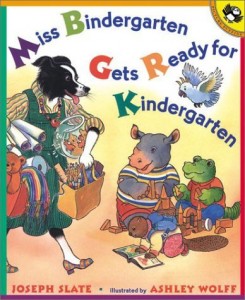 It has been a very big week in the life of Harriet, who successfully underwent her first trip to the dentist (without a cavity to show for it!) on Tuesday and who this afternoon was registered for kindergarten in September. Initially, she was nervous about all the big kids and stuck close to me, until she was whisked away by a group of grade 6 “school ambassadors” who played with her while I filled out the paperwork. And then Harriet was presented with a brand new book, her own copy of Miss Bindergarten Gets Ready for Kindergarten, which we’ve had out of the library many, many times. It was a wonderful introduction to the kindergarten life, and Harriet is looking forward to it. I only cried a little bit.
It has been a very big week in the life of Harriet, who successfully underwent her first trip to the dentist (without a cavity to show for it!) on Tuesday and who this afternoon was registered for kindergarten in September. Initially, she was nervous about all the big kids and stuck close to me, until she was whisked away by a group of grade 6 “school ambassadors” who played with her while I filled out the paperwork. And then Harriet was presented with a brand new book, her own copy of Miss Bindergarten Gets Ready for Kindergarten, which we’ve had out of the library many, many times. It was a wonderful introduction to the kindergarten life, and Harriet is looking forward to it. I only cried a little bit.
February 6, 2013
Pennies Saved
 I hate change of all sorts, except the monetary kind, and so I naturally am very unhappy about the demise of the penny. And so, in my efforts to render the penny eternal, I’ve decided to keep a glass jar full of them until the end of time (or at least until we decide to move, and I wonder if it’s really necessary to preserve a jar of pennies). I’ll display the jar high on a shelf, and one day I’ll show it to my grandchildren who will barely be able to fathom that there was ever such a thing as a one cent coin.
I hate change of all sorts, except the monetary kind, and so I naturally am very unhappy about the demise of the penny. And so, in my efforts to render the penny eternal, I’ve decided to keep a glass jar full of them until the end of time (or at least until we decide to move, and I wonder if it’s really necessary to preserve a jar of pennies). I’ll display the jar high on a shelf, and one day I’ll show it to my grandchildren who will barely be able to fathom that there was ever such a thing as a one cent coin.
But while all that is still in the future, my little daughter and I sat down this afternoon to sort through the coins in our family’s change jar and take the pennies out. And really, there is no better companion than a three-year-old for such a project. We had a very good time picking out the pennies and guessing if they were old or new based upon their shininess or tarnish. 2009 pennies we decided were Harriet pennies, “from the year you were born!” and pennies from the years after amazing because Harriet was older than they were. We were quite excited to find 1979 pennies too, as old as Dad and Mom. Lots of 1984, and 1992, commemorating Canada’s 125th. And then we found a 1969, which was exciting, and a 1967, which was the most exciting year of all. The oldest penny we found was from 1958, when the Queen looked remarkably young.
Our little jar isn’t filled yet, which means we’ll have to be keeping an eye out for pennies even as they become increasingly rare. In their rarity too, I think, they’re only going to become a little more magic, and really, haven’t they ever been?
February 6, 2013
Blogging Like No One is Reading
 Blogging stats are important*, and I pay attention to mine, so I was a bit dismayed last summer when my traffic levels plummeted. Part of the problem of course was that it was summertime, when traffic always falls down a bit, but that didn’t fully explain what had happened. But then these things (particularly online things) are always about ebb and flow, popularity is fleeting, and I’ve found that whenever I get too confident about anything I’m up to, life itself has an amazing ability of administering a kick in the ass–which is always useful, I think, in healthy doses.
Blogging stats are important*, and I pay attention to mine, so I was a bit dismayed last summer when my traffic levels plummeted. Part of the problem of course was that it was summertime, when traffic always falls down a bit, but that didn’t fully explain what had happened. But then these things (particularly online things) are always about ebb and flow, popularity is fleeting, and I’ve found that whenever I get too confident about anything I’m up to, life itself has an amazing ability of administering a kick in the ass–which is always useful, I think, in healthy doses.
So what does a blogger do when her traffic falls off? I, of course, turned to my number one piece of blogging advice, which is Blog like no one is reading. It’s advice that is always useful, and never more so than during those times when no one is, in fact, reading. Blogging like no one is reading runs counter to traditional advice, which is to write for your audience, which is to jump through hoops and perform virtual naked tapdances in order to garner online attention, but I find such advice is always delivered by folks without a clue of what blogging is all about, with no real sense of the tradition it was born from.
To do the opposite of blogging like no one is reading is terrible advice for a variety of reasons. First, because most of the time, no one is going to be reading, and so there has to be something more than feedback from the outside world to push a novice blogger on. Second, because you’re never going to be able to predict what readers will respond to and what they won’t. It’s the strangest serendipity, and attempts to orchestrate this will absolutely drive you crazy. It will also result in the naked tap-dancing that just looks ridiculous, and never more so than when it doesn’t work and still, no one is reading. And there you are in your feather boa and your silly top hat, when dancing wasn’t even what you planned to be doing in the first place.
People to come for blogging for a variety of reasons. For many writers, a blog offers a way to keep a website up-to-date and active. An effective blog can be as simple as a news and events page updated monthly or so. Others come to blogging because they were advised to, because it would help their online cachet, though they don’t fully believe in the spirit of the thing. They believe that the blog is to bring forth results (ie traffic, ie book sales, ie fame and fortune) when the fact of the matter is that a blog, at its most bloggish, is its own final product. So many of us blog for the sake of the blog itself, a work of art, a creation, as eternal as a thing can be in ephemeral world of the internet. The blog is the point, the one thing you have control over anyway, rather than what anyone else happens to do with it.
The thing about blogging like no one is reading is that you really can’t go wrong. And you’ll find that this is precisely what the most amazing and popular bloggers out there have been doing all along anyway–creating something original and personal with their own interests in mind. That reams of followers were interested too was really just happenstance. (There are exceptions to this, but these are so often marketing tools rather than blogs proper. And if you don’t see the distinction between the two, then you and I were never really on the same page in the first place. And you don’t know what a blog is. But I digress…)
The thing about blogging like no one is looking is that it gives you some perspective, allows you to take a real good look at what you’re doing and why you’re doing it, and change and develop accordingly. It is easy to get caught up in a run for readers, but when winning traffic becomes your sole preoccupation, then you’re doing blogging wrong. You’re probably not having fun either.
Anyway, of course, these are all the things you tell yourself during the summer that your blog’s traffic plummets. These are the things that offer consolation. And then when you discover that the reason behind the plummet was that your blog has been hacked and is now (unknown to you) packed full of invisible ads for Viagra and therefore search engines have seen fit to abandon you and so too has all your organic search traffic, well, you get your hack fixed of course. And the numbers come back. But you just keep on doing what you’ve been doing, blogging like they haven’t, which is what you should have always been doing in the first place.
*Note: Blogging like no one is reading and paying attention to blogging stats are not necessarily contradictory. Each has its uses.
